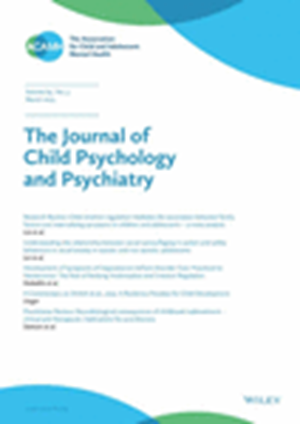围产期困难和婴儿神经发育:来自全球流行病的见解。
IF 7
1区 医学
Q1 PSYCHIATRY
引用次数: 0
摘要
背景怀孕期间的物质和情感困难会影响婴儿早期的大脑发育和行为。本研究将COVID-19大流行作为自然背景,其中这种困难普遍存在,特别是在资源匮乏的环境中。方法本队列研究考察了与大流行相关的母亲情绪困扰和怀孕期间物质困难与婴儿早期神经发育结局之间的关系。在2019冠状病毒病大流行期间,来自巴西资源匮乏的医疗机构的235对母婴进行了登记。使用针对COVID-19的问卷(包括自我报告的COVID-19暴露/感染)评估产妇的困难。婴儿神经发育在2-6周龄时通过MRI进行评估,14个月时使用Bayley婴儿发育量表进行行为评估。结果物质困难与左半球(pfdr = 0.008)和右半球(pfdr = 0.025)海马体积减小有关。在女婴中,物质困难与右侧海马体和右侧吻侧前扣带皮层之间较低的功能连通性有关(p = 0.004)。14个月时,海马体积较小与粗大运动技能较弱相关(r = 0.23; p = 0.02)。母亲情绪困扰和自我报告的COVID-19暴露/感染与婴儿神经发育结局无显著相关。结论物质困难可能对早期神经发育产生不利影响,特别是海马结构和连通性,并可能对运动技能产生下游影响。这些发现强调了解决围产期物质困难以支持婴儿大脑健康和发育的重要性。本文章由计算机程序翻译,如有差异,请以英文原文为准。
Perinatal hardship and infant neurodevelopment: insights from a global pandemic.
BACKGROUND
Material and emotional hardship during pregnancy can shape early brain development and behavior in infants. This study used the COVID-19 pandemic as a natural context in which such hardships were widespread, particularly in low-resource settings.
METHODS
This cohort study examined associations between pandemic-related maternal emotional distress and material hardship during pregnancy and early neurodevelopmental outcomes in infants. A total of 235 mother-infant dyads from low-resource healthcare settings in Brazil were enrolled during the COVID-19 pandemic. Maternal hardships were assessed using a COVID-19-specific questionnaire, which included self-reported COVID-19 exposure/infection. Infant neurodevelopment was evaluated via MRI at 2-6 weeks of age and behavioral assessments at 14 months using the Bayley Scales of Infant Development.
RESULTS
Material hardship was associated with reduced hippocampal volumes in the left (pfdr = .008) and right (pfdr = .025) hemispheres. Among female infants, material hardship was linked to lower functional connectivity between the right hippocampus and the right rostral anterior cingulate cortex (p = .004). Smaller hippocampal volumes correlated with weaker gross motor skills at 14 months (r = .23; p = .02). Maternal emotional distress and self-reported COVID-19 exposure/infection were not significantly associated with infant neurodevelopmental outcomes.
CONCLUSIONS
Material hardship may adversely affect early neurodevelopment, particularly hippocampal structure and connectivity, with potential downstream effects on motor skills. These findings underscore the importance of addressing material hardship during the perinatal period to support infant brain health and development.
求助全文
通过发布文献求助,成功后即可免费获取论文全文。
去求助
来源期刊
CiteScore
13.80
自引率
5.30%
发文量
169
审稿时长
1 months
期刊介绍:
The Journal of Child Psychology and Psychiatry (JCPP) is a highly regarded international publication that focuses on the fields of child and adolescent psychology and psychiatry. It is recognized for publishing top-tier, clinically relevant research across various disciplines related to these areas. JCPP has a broad global readership and covers a diverse range of topics, including:
Epidemiology: Studies on the prevalence and distribution of mental health issues in children and adolescents.
Diagnosis: Research on the identification and classification of childhood disorders.
Treatments: Psychotherapeutic and psychopharmacological interventions for child and adolescent mental health.
Behavior and Cognition: Studies on the behavioral and cognitive aspects of childhood disorders.
Neuroscience and Neurobiology: Research on the neural and biological underpinnings of child mental health.
Genetics: Genetic factors contributing to the development of childhood disorders.
JCPP serves as a platform for integrating empirical research, clinical studies, and high-quality reviews from diverse perspectives, theoretical viewpoints, and disciplines. This interdisciplinary approach is a key feature of the journal, as it fosters a comprehensive understanding of child and adolescent mental health.
The Journal of Child Psychology and Psychiatry is published 12 times a year and is affiliated with the Association for Child and Adolescent Mental Health (ACAMH), which supports the journal's mission to advance knowledge and practice in the field of child and adolescent mental health.

 求助内容:
求助内容: 应助结果提醒方式:
应助结果提醒方式:


